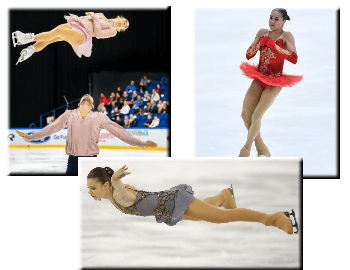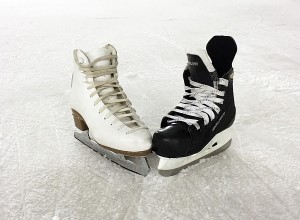
There aren’t all that many sports that combine drama, excitement, grace, glamour, emotion and athleticism like figure skating. Skaters spend hours training and it all has to come together in around six or seven minutes, in front of a panel of judges. We hold our breath when they transform themselves into a spinning blur that lasts less than a second and hope they will land successfully after graceful jumps.
When we watch figure skating on the TV and listen to the commentators talking about the different jumps, do we really appreciate exactly what is involved? Each jump is over in just a couple of seconds and we barely get a chance to see which direction they rotated in. The vast majority of skaters perform all their jumps and spins in the same direction, usually counter-clockwise. Clockwise jumps and spins are far less common.
How are figure skating jumps classified?
There are basically, two different types of figure skating jumps: edge jumps or toe jumps. If a skater performs an edge jump they take off directly from the edge of the skate without any assistance from the other foot. With a toe jump a skaters spokes the toe picks of the free foot into the ice right when they are jumping off the edge of the skating foot. A similar kind of action is used by a pole vaulter. It serves to convert a skater’s horizontal speed over the ice into a vertical motion.
Figure skating jumps technique
Most jumps performed in figure skating have a natural rotation. In other words the approach and the landing curves are executed in the same direction as the jump in the air. A few jumps are a little different, in that they are counter-rotated. In these cases the approach edge has an opposite rotation to the rotation in the air and the landing curve. The Lutz and Walley are two examples of counter-rotational jumps.
The six most common figure skating jumps
What follows is a list of the most common jumps ordered from the easiest to the most difficult. In accordance with the point values given to the jumps under the ISU Judging system. All of the jumps take off from a backwards entrance. The Axel jumps is one exception.
- Toe loop jump – a toe jump taking off from a back outside edge and landing in the same back outside edge. Also known in Europe as a cherry flip. This jump can be performed straight after other jumps in combinations. When performed as a solo jump they tend to be entered from a three turn.
- Salchow jump – a jump named after its originator, Ulrich Salchow. This is an edge jump that takes off from a back inside edge and lands on the back outside edge but on the opposite foot. It’s most often preceded by a forward outside 3 turn.
- Loop jump – another edge jump that requires the skater to launch from the back outside edge and land on the same back outside edge. In Europe, it’s also know as the Rittberger, named after its inventor. Loops can be performed in combination with other jumps.
- Flip jump – this is a toe jump that requires the skater to take off from a back inside edge and land on the back outside edge of the opposite foot. It usually precedes a forward outside 3 turn or forward Mohawk.
- Lutz jump – a toe jump that takes off from a back outside edge and lands on the back outside edge of the opposite foot. Named after its originator, Alois Lutz, it’s one of only a few counter-rotated jumps. It’s easy to identify a Lutz jump by the long, backward diagonal glide preparation.
- Axel jump – an edge jump launched on the forward outside edge and landing on the back outside edge of the opposite foot. It has a forward takeoff, but a backwards landing. So, in actual fact, an Axel has half an extra rotation.

There are a number of other jumps worth mentioning. But these are usually performed only as single jumps and often used as transitional movements or as highlights in step sequences.
Other figure skating jumps
- Bunny hop jump – a non-rotational jump that is usually the first jump for beginners
- Waltz jump – one-half rotational jump forming the basis for the Axel jump
- Ballet jump – one-half rotation jump with a toe loop entrance
- Mazurka – one-half rotation jump with a toe loop entrance and scissor leg action when in the air
- Half flip – one-half rotation jump with a flip entry and forward toe-pick assisted landing
- Half Lutz – one-half rotation jump with a Lutz entry and forward toe-pick assisted landing
- Falling leaf – one-half rotation jump with a loop entry and forward toe-pick assisted landing
- Walley jump – a dull-rotation edge jump with a counter-rotated entry from a back inside edge to the back outside edge of the same foot
A number of figure skating jumps can only be performed with two people, so let’s finish up with a few jumps you can see in pair skating.
Jumps in pair skating
- Side by side – side by side jumps are a requirement in competitive pair skating. Lower competition levels may require specific jumps. Elite-level pair skaters usually try at least one of either a double Axel, triple toe loop or triple Salchow.
- Throw jumps – throw jumps are another requirement in competitive pair skating. A throw jumps involves the lady being assisted on a standard jump by her partner. After which she will land on a back outside edge just like she would if she were jumping alone.